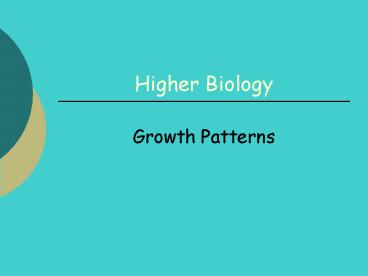Higher Biology - PowerPoint PPT Presentation
1 / 15
Title:
Higher Biology
Description:
Title: Health and Technology Author: Davis Last modified by: Any Authorised User Created Date: 6/15/2005 3:08:39 PM Document presentation format: On-screen Show – PowerPoint PPT presentation
Number of Views:25
Avg rating:3.0/5.0
Title: Higher Biology
1
Higher Biology
- Growth Patterns
2
Plant Growth
- By the end of this lesson you should be able to
- Describe how growth is measured.
- Know what a growth curve is.
- Describe growth patterns in an annual plant.
- Describe growth patterns in a tree.
- Describe growth patterns in a human.
- Describe growth patterns in a locust.
3
Measuring growth
- Remember growth is an irreversible increase in
the dry mass of an organism. - Since this kills the organism, biologists tend to
use - Fresh body mass,
- Body height or length
- Length of roots or shoots
- As measures of growth.
4
Growth Curves
- These graphs show the growth of an organism over
time. - When you water a plant which has not been watered
for some days and has wilted, its mass increases.
Why can this not be described as growth? - Why do you think it is less reliable to measure
the fresh mass of an organism rather than dry
mass?
5
Growth Curves
- You have been given 4 growth curves.
- Which one corresponds to
- An annual plant?
- A tree?
- A human?
- A locust?
6
Annual Plants
- An annual plant grows for one year and then
stops. - Label the appropriate graph as that of an annual
plant.
7
Annual Plants- growth patterns
- On your graph there are three stages.
- Label them 1, 2 and 3.
- Match up the following explanations to the stage
it is describing.
Decrease in dry mass during germination, as food
reserves used up for respiration to
generate energy for growth
Increase in dry mass as photosynthesis
exceeds respiration and growth occurs
Curve flattens out, seeds disperse and the
plant undergoes senescence
8
Trees
- Trees are perennials- i.e. live for many years,
many beyond 1000 years. - These type of plants grow by secondary growth.
- Label the appropriate graph as that of a tree.
9
Trees
- Each year there is a sigmoidal curve, similar to
that of an annual plant but on a smaller scale. - Each year spring and summer provide the best
growing conditions. - During winter growth slows and comes to a
complete stop. - Label on your tree growth curve
Spring and summer
Winter
10
Humans
- Humans are considered to be fully grown by the
age of 25. - Label the appropriate graph as that of a human.
11
Humans- growth patterns
- On your graph there are two phases of rapid
growth. - There are also two lines, overlapping at times,
one for males and one for females. - Label the growth spurts 1 and 2.
- Match up the following explanations to the stage
it is describing. - Describe 2 differences between the curve of a
male and female.
Infant growth spurt
Adolescent growth spurt
12
Insects
- Insects have a hard exoskeleton, which prevents
them growing continuously. - In order to growth the insect must shed its
exoskeleton (moulting or ecydysis) and increase
in body size before the new exoskeleton hardens. - Label the appropriate graph as that of a locust.
13
Locust- growth patterns
- On your graph there are two lines, one for body
mass and one for body length. - Label each line appropriately.
- Label the moult points.
- Why does the mass of the locust drop slightly at
each moult? - Insert and complete the Growth in Plants v
Animals table from your diagram pack.
14
Practice Questions
- Torrance
- AYK pages 233-234 Q1 and 4
- Give an account of how plants grow and the
formation of annual rings 10 marks. - One mark is for coherence and one is for
relevance.
15
Plant Growth
- Can you do it?
- Describe how growth is measured.
- Know what a growth curve is.
- Describe growth patterns in an annual plant.
- Describe growth patterns in a tree.
- Describe growth patterns in a human.
- Describe growth patterns in a locust.































